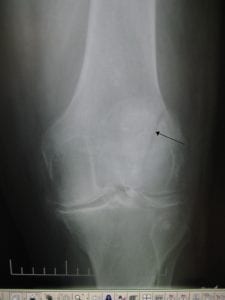Are Stress Fractures from Osteoporosis Drugs an Emerging Epidemic?
There is no doubt that we at Searcy Denney are seeing more and more cases of bone fractures that are occurring among women taking bisphosphonates to treat osteoporosis and osteopenia. But there may be even more cases out there that are going unreported.
The authors of this article, William Ward and Christina Carter of Wake Forest University, Department of Orthopaedic Surgery, report that frequently patients who are suffering the complications associated with long term use of bisphosphonates may be going undiagnosed.
Reporting in The Journal of Bone & Joint Surgery (British Volume), the authors found several patients they observed who had completely fractured their femur prior to seeing a doctor. These are patients who had been diagnosed with osteoporosis and treated with a variety of bisphosphonates, alendronate (Fosamax) among, them for a long time, but because the stress fractures were subtle, the clinicians were unfamiliar with the abnormalities.
The authors review a series of 17 femoral stress fractures among patients with osteoporosis taking the class of drugs to illustrate what some of these more subtle changes might look like.
 One common lesion is known as the “dreaded black line” or a stress fracture which is surrounded by a cortical thickening of the endosteal (lines bone marrow cavity) and periosteal bone (outer surface of the bone) which is best seen with a CT scan. Using an MRI, the researchers suggest it could appear to be a tumor. Some clinicians even misdiagnose the fractures as bursitis.
One common lesion is known as the “dreaded black line” or a stress fracture which is surrounded by a cortical thickening of the endosteal (lines bone marrow cavity) and periosteal bone (outer surface of the bone) which is best seen with a CT scan. Using an MRI, the researchers suggest it could appear to be a tumor. Some clinicians even misdiagnose the fractures as bursitis.
It is interesting to note that the article’s title is “Bisphosphonate-Associated Subtrochanteric Stress Fractures: An Emerging Epidemic.”
And bone fractures are not the only complication resulting from bisphosphonate use. This class of drugs that include Fosamax, Boniva, Actonel, and Reclast among others, has also been linked to an increased risk of atrial fibrillation and osteonecrosis of the jaw.
The National Osteoporosis Foundation reports that by the year 2020, half of the women over the age of 50 will have osteoporosis as well as about 30 percent of men, so it is crucial for patients and their doctors to understand the downside of risks versus the upside of benefits.
Share This


